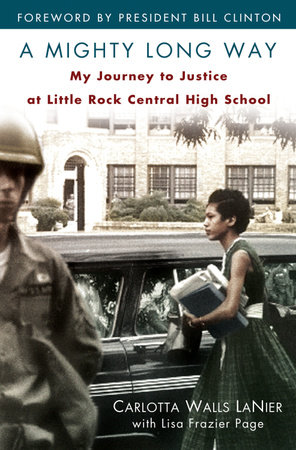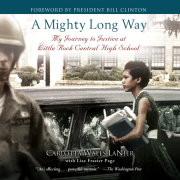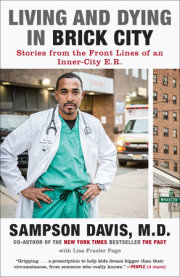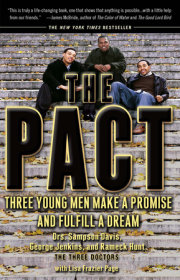Chapter One
A Different WorldFor the longest time, I wanted nothing more to do with Little Rock. After leaving in 1960, I returned only when necessary, usually for funerals. But my work as president of the Little Rock Nine Foundation brings me home often these days, and I inevitably wend my way down Interstate 630 to my old neighborhood. Most often, I go there to see Uncle Teet, who still lives in my great-great grandfather Hiram Holloway’s old house, five houses down from the one where I grew up. But every now and then, I pull up alongside the redbrick bungalow at 15th and Valentine streets, park the car, and get out.
This was the center of my world as a child. The place looks abandoned with its boarded-up windows and weeds where lush green grass used to grow. There is no sign of the big gardenia bush that once graced the front yard. Mother would pick a fresh flower from that bush and place it in her hair just so, like Billie Holiday. But the gardenias are long gone. So, too, is the tree in the backyard that used to grow the plumpest, sweetest figs around. The pecan tree still stands, and as I picked up a few dried nuts one scorching summer day, I was reminded of the lean Christmas in junior high school when that tree provided perfect homemade gifts for most of my family and friends. Money was tight that year, so I made date-nut cakes from the bounty in our backyard to give away as presents. There were three of those huge trees, perfectly aligned in a row from our yard to the Davises’ yard next door to the other Davis property down the street. So, of course, someone in the neighborhood was always making homemade pecan ice cream or baking pecan pies or some kind of nut cookies or cake.
I’m amazed at how small it all seems now—our house, the yard, and even those pecan trees, which to a little girl staring up seemed just a few steps from heaven. I still call the place “our house,” as if it remains in my family. But Mother finally sold it several years ago when the upkeep became too much and I convinced her that none of her three girls would ever return. She was reluctant at first to let go. The memories, I guess. And our family roots—they run pretty deep through there.
I was three years old when Daddy bought the house at 1500 S. Valentine Street, just blocks away from the all-white Central High School. Even then, the school was known throughout the country for its Greek-inspired architecture, beauty, and high academic achievement. Daddy had just returned from the Philippines, where he served in World War II until December 1945. Mother was weary of having moved with me at least four times, mostly among relatives, while he was away. My parents paid $3,000 for the house, sold to them by my mother’s grandfather, Aaron Holloway, who had raised her practically all of her life after his daughter moved away to St. Louis.
Papa Holloway, as I knew my great-grandfather, looked like a Spaniard with his tan skin, dark eyes, thick, wavy black hair, and mustache. I’m told that in his younger days, his hair would sprout into a nest of thick black curls—and thus the source of his nickname among some of our neighbors: Curly. He stood about six feet tall, and family members say that I—tall and slender as a child—inherited his height and thin build. I probably inherited some of his other characteristics, too, like my hair, which is naturally pretty wavy. When I was a child, it grew like weeds, so long and thick that I had trouble grooming it, and Mother had to plait it into neat braids or pull it into ponytails until I was well into junior high school. I wasn’t allowed to get my first haircut until eighth grade, and I’ve mostly kept it short ever since.
The Spanish roots in my family tree can be traced back to Papa Holloway’s father, Hiram. I never knew him, but in recent years I’ve read interviews he granted to federal workers in the 1930s for a collection of ex-slave narratives as part of the Federal Writers’ Project. Hiram was described in the report as a “tri-racial free person of color,” born in 1848, about thirteen years before the Civil War. He said in a transcript of the interview that his mother was a “full-blooded Cherokee” and his father a “dark Spaniard.” He used the N-word liberally as he talked about the Africans who were enslaved. That word still stings when I see or hear it, but
I’ve tried to refrain from harsh judgment of my great-great- grandfather, even as he set himself apart from the slaves. As difficult as some parts of his story were to digest, the interview re-
minded me just how much my ancestors endured in their pursuit of education, generations before I ever stepped foot onto Central.
“In slave times, they didn’t have any schools for niggers,” said Hiram, who managed to learn to read and write. “Niggers better not be caught with a book. If he were caught with a book, they beat him to death nearly. Niggers used to get hold of this Webster’s Blue Back Book and the white folks would catch them and take them away. They didn’t allow no free niggers to go to school either in slave times.”
Hiram’s story gave me fresh insight into how much my family valued education even then. He expressed disappointment that the younger generation of blacks—those born after the Civil War—didn’t seem as persistent as their forefathers in the quest for education. His words are still relevant; they capture some of my concerns today:
“One thing, they don’t read enough,” he said. “They don’t know history. I can’t understand them. Looks like they had a mighty good chance; but it looks like the more they get the worse they are. Looks like to me their parents didn’t teach them right—or somethin’.”
Although Hiram referred repeatedly in the interview to his wife and children, little is known about most of them in our family. I once asked Papa Holloway about his brothers and sisters. He told me he had several siblings but that he knew the whereabouts of only one, a sister, Maude, who lived in Cleveland. He said that he suspected his other brothers and sisters were scattered throughout the country and passed as white. But Papa Holloway identified himself as “colored” and was proud of the status he achieved as one of the first colored building contractors in Arkansas. He helped to build houses throughout Arkansas, including many of the higher-end homes in the wealthy white Pulaski Heights neighborhood in Little Rock. He also built White Memorial Methodist Church, just up the street from my house. Much of my family worshipped there. Papa was on the board of trustees, a real mover and shaker who was there practically every time the doors of the church opened. Most Sundays, I sat beside him on the front pew.
Papa’s wife, Mary, died in 1922 at age thirty-four while giving birth to their sixteenth child. The baby girl died, too, as did a set of twins who had been born earlier. Papa raised the remaining children and never married again. His oldest son, Hugh, would become one of only two black men who worked as skilled laborers on Central High School when it was built. Papa’s longtime girlfriend, Dora Holmes, was a widow who lived down the street and owned the house at 1500 S. Valentine Street. Mother and I stayed with her briefly while my father was away at war. How much of my memory of Mrs. Holmes is influenced by family stories, I don’t know. But I remember being terrified of her. She dressed like a witch or a woman on the frontier, in long black cotton dresses and black high-top boots. I didn’t realize then that she may have been trying to cover a prosthetic leg.
On some Sunday mornings, my paternal grandfather, Big Daddy, would drop me off at Mrs. Holmes’s house after I had spent the weekend with him. As soon as we approached the house, I’d start screaming and hollering that I didn’t want to go. I’d fall out, kicking and wailing, on the front porch. But when the front door opened silently, I saw from the corner of my eyes those high-top boots and the hem of her long black dress moving toward me. I immediately turned off the tears, rose to my feet, and followed Mrs. Holmes inside as though I had some sense.
When Dora Holmes died, she left her estate in the care of Papa Holloway, who offered the house to my father. None of us could have imagined then how much that address would dictate the course of our lives in the years ahead. The house was located just west of downtown Little Rock, a few miles beyond 9th Street, which was then a bustling strip of black-owned businesses and nightspots. The community surrounding 9th Street was all black. My end of town was more racially mixed—black families lived on one block, whites on the other. In some cases, black and white families lived across the street from one another. But our white neighbors may as well have been living on Mars for all we knew of their lives. When my family moved there, the neighborhood was still new. Most of the houses were box-shaped with wooden frames, built along a grid of narrow dirt roads after World War II. They were modest but well kept. A few had porches, and most had small yards, though they didn’t seem small then. Our house stood out because Daddy, who earned a living as a brick mason, meticulously covered it from top to bottom with the same red bricks that remain on the house today. The only other brick house in the neighborhood belonged to Papa Holloway.
Daddy had learned the brick masonry trade from his father-in-law, Med Cullins, a master contractor who did brick masonry work on Central High in the 1940s. Grandpa Cullins, my mother’s father, was a real character. He was a big, imposing man who stood over six feet tall with a heavyset frame, a gravelly voice, and a gruff disposition that matched his size. His beige skin and straight hair gave him the appearance of a slightly tanned white man. He walked with his shoulders squared and head high and carried a half-pint of liquor stuffed in his back pocket. He also couldn’t finish a sentence without at least one “goddamn.” Grandpa was his own man. He had one suit and wore mismatched socks, but he considered those kinds of things trivial. When I met Thurgood Marshall in later years, his aura reminded me in an odd way of Grandpa Cullins. Neither man kowtowed to anyone. Confidence seemed to radiate from them both, but the likeness ended there.
Grandpa Cullins had an intimidating—and sometimes crude—presence, which worked to his advantage when it came time to collect from someone who had hired him to do a job. He could be less than forgiving on money matters, even if the delinquent client was a house of worship.
“Your father just embarrassed the heck out of me,” I heard my father tell Mother one Sunday afternoon when I was in junior high school after the two men returned from a church service in a nearby town.
Grandpa Cullins had asked Daddy to drive him to the church. But as the service wound to a close, the pastor made the mistake of recognizing my grandfather to say a few words. Grandpa Cullins strolled to the front, told the congregants what a pretty goddamn church they had, but he reminded them that he was still waiting for his money.
Grandpa was not a patient man. He called every man “son” and every woman “daughter,” including his own children and grandchildren, who say he did so because he didn’t want to bother remembering any names.
“Daughter, let me speak to daughter,” he commanded one day when I answered the phone at home.
I looked at Mother and her sister and responded: “Which one?”
“Goddammit,” Grandpa barked. “The one who lives there!”
Grandpa Cullins had dropped out of Philander Smith College in Little Rock to start his contracting business, but he was a highly intelligent man who stayed abreast of current events. He’d insisted that his four children—Mother, her younger brother, and two older sisters—go to college. The schools of choice were Philander Smith or Talledega College in Alabama. Grandpa loved politics, particularly presidential history. Many times, I heard him start with Truman and work his way back, reciting the years each president served, the president’s party, and something significant about each man’s time in office. But when Grandpa got to Taylor, he always said, “And next is that goddamn Zachariah Taylor. . . .”
At first, I didn’t understand what he meant, so I asked: “What’s wrong with Zachary Taylor?”
“That’s Sam Mumford’s grandfather,” Grandpa Cullins responded, referring to his good friend and fellow contractor.
“Oh, Grandpa, you know a president wouldn’t marry a colored woman,” I shot back.
He looked at me with a sly grin. “Whoever said anything about getting married?”
Grandpa Cullins never married my mother’s mother. Mother was born to Erma Holloway while he was separated from his wife, Beatrice. He and Beatrice reunited, and soon afterward my maternal grandmother moved away to St. Louis and left Mother with Papa Holloway. I knew Beatrice as Grandmother Cullins and her children as my aunts and uncles. Mother and her siblings never thought of themselves as half of anything. We’ve always just been family. Grandmother Cullins was fifty-five when she died of stomach cancer in 1951.
All of my grandfathers outlived their wives. While I was nurtured by a cadre of well-educated and loving women, I spent a lot of time around the men on both sides of my family. And they heavily influenced the woman I became. The independent streak that I’m sure I inherited from my grandfathers would land me at Central in the days ahead, and the determination I witnessed in all of their lives would help me survive the toughest days there.
No one was more determined than my Big Daddy. He was Porter Walls, my father’s father. He had mahogany skin and a medium build and stood about five feet five inches tall, on the short side for a man. He had only a third-grade education, but he could read and write and was one of the smartest businessmen I’ve ever known. He owned and operated a pool hall and restaurant in a red cinder-block building that extended about a half block at the intersection of 18th and Pine streets, a short walk from my house. Big Daddy enjoyed looking like a businessman, so his preferred attire was a suit and hat when he wasn’t in the kitchen. He also smoked cigars.
Copyright © 2009 by Carlotta Walls Lanier. All rights reserved. No part of this excerpt may be reproduced or reprinted without permission in writing from the publisher.












